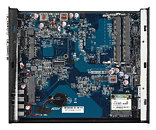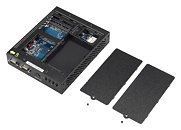Sunday, February 22nd 2015

Shuttle Comes with First Broadwell-based Fanless PC
Following the introduction of the XH97V and SH97R6 barebone PC models that have been prepared for the fifth generation of Intel Core processors, Shuttle today introduces a new member to the product family - the DS57U. This is the company's first barebone PC with a built-in Broadwell processor. As a successor to the DS47 and DS437 models, the DS57U also belongs to the 1 litre PC class. The DS57U is delivered as a barebone PC and includes the case, motherboard, cooling system and power supply unit as its core components as standard.
The system is powered by a pre-installed Intel Celeron 3205U dual-core processor (2x 1.5 GHz), which also is part of the delivery. The 14-nm architecture and power consumption of less than 15 W promise low energy costs together with improved performance. The completely fanless DS57U not only works remarkably quietly, it is almost maintenance-free, as the passive cooling ensures that no dust is sucked into the machine.Once the two screws on both covers of the steel case are undone, space for one 2.5" hard drive or SSD drive and two SO-DIMM sockets with a capacity for up to 16 GB of DDR3L memory comes to light. One Mini-PCI Express slot (full-size) is available for additional expansions, e.g. an mSATA module. A second Mini-PCI Express slot (half-size) comes already fitted with a WLAN module.
With its ultra-slim dimensions of 20 x 3.95 x 16.5 cm (DWH), the DS57U as the first Shuttle barebone sports two Intel Gigabit Ethernet interfaces. Plus, 2x USB 3.0, 1x DisplayPort, 1x HDMI and audio ports can be found. Also at the rear side of the machine sits a multi-pin connector for remote power-on (e.g. in the case of fixed installation in an awkward position). The front panel unveils a card reader, four USB 2.0 ports and two RS-232 interfaces for connecting peripheral devices.
"We are delighted to expand our product family with the DS57U, which adds the latest Intel processor generation to our portfolio. We see the DS57U as a versatile PC platform, which can in principle be used wherever efficiency, quietness and longevity are required. For Shuttle, this also means a further step in the direction of vertical markets where precisely these features are in demand," says Tom Seiffert, Head of Marketing & PR at Shuttle Computer Handels GmbH.
The DS57U can be operated in various positions, e.g. upright or mounted on suitable surfaces or monitors with the supplied VESA mount.
The recommended retail price for the Shuttle Barebone DS57U is EUR 192.00 (ex VAT). The machine launched with this press release is available from specialist retailers Europe-wide as of now.
The system is powered by a pre-installed Intel Celeron 3205U dual-core processor (2x 1.5 GHz), which also is part of the delivery. The 14-nm architecture and power consumption of less than 15 W promise low energy costs together with improved performance. The completely fanless DS57U not only works remarkably quietly, it is almost maintenance-free, as the passive cooling ensures that no dust is sucked into the machine.Once the two screws on both covers of the steel case are undone, space for one 2.5" hard drive or SSD drive and two SO-DIMM sockets with a capacity for up to 16 GB of DDR3L memory comes to light. One Mini-PCI Express slot (full-size) is available for additional expansions, e.g. an mSATA module. A second Mini-PCI Express slot (half-size) comes already fitted with a WLAN module.
With its ultra-slim dimensions of 20 x 3.95 x 16.5 cm (DWH), the DS57U as the first Shuttle barebone sports two Intel Gigabit Ethernet interfaces. Plus, 2x USB 3.0, 1x DisplayPort, 1x HDMI and audio ports can be found. Also at the rear side of the machine sits a multi-pin connector for remote power-on (e.g. in the case of fixed installation in an awkward position). The front panel unveils a card reader, four USB 2.0 ports and two RS-232 interfaces for connecting peripheral devices.
"We are delighted to expand our product family with the DS57U, which adds the latest Intel processor generation to our portfolio. We see the DS57U as a versatile PC platform, which can in principle be used wherever efficiency, quietness and longevity are required. For Shuttle, this also means a further step in the direction of vertical markets where precisely these features are in demand," says Tom Seiffert, Head of Marketing & PR at Shuttle Computer Handels GmbH.
The DS57U can be operated in various positions, e.g. upright or mounted on suitable surfaces or monitors with the supplied VESA mount.
The recommended retail price for the Shuttle Barebone DS57U is EUR 192.00 (ex VAT). The machine launched with this press release is available from specialist retailers Europe-wide as of now.




14 Comments on Shuttle Comes with First Broadwell-based Fanless PC
I have loved Shuttles ever since i had my first one, they sit on a shelf and do everything an office might need.
I fitted a gaming gpu in one for my daughter but i had to cut a hole in the case so the fan could get some air.
The number of cores and number of GHz means nothing on its own. You are comparing a 2013 processor to a 2015 processor. They have different architecture and different amounts of optimization.
J1900 is still better option because Intel Celeron 3205U has not enough processing power for all these additional features that J1900 lacks. VT-d is great but in this case and with this performance you won`t need it.
IMC-level memory sub-systems!
- Size of the L1 Cache.
- The J1900 has 224KB of L1 cache (128KB code, 96KB data).
- The 3205U has 128KB of L1 (64KB for code and data).
- Size of the L2 Cache.
- The J1900 has 2MB of L2 Cache.
- The 3205U has 512KB of L2 Cache.
- Size of the L3 Cache.
- The J1900 does not have a L3 cache.
- The 3205U has a 2MB L3 cache.
- External memory interface (DDR3)
- J1900 supports DDR3-1333.
- 3205U supports DDR3-1600.
Arguments for the J1900: It has a larger L1 cache, so instructions will hit more often than a smaller cache. Being the fastest level of cache, it's important to have enough of it without "missing" the cache too often. The same deal with the L2 cache, which is something AMD went heavy on as well so make up for caching hit/miss ratios on memory accesses. The drawback is the larger you make the cache level, the more latency will get introduced because of the size of the SRAM array.Arguments for the 3205U: It has a smaller L1 cache which could be a bad thing, but that depends a lot more on the rest of the memory hierarchy. The big thing with this CPU is that it has 3 levels of cache where the smaller (and most likely faster as a result) L2 cache on the 3205U make up for latency where the L3 makes up for the amount of cache. So while without seeing a real benchmark, I could see the 3205U gaining some IPC headway over the J1900 as a result of the differences in the caching hierarchy and faster external memory.
Now, this isn't to say the 3205U is faster than the J1900, but it adds an interesting dynamic.Do you even know what VT-d is used for? You don't necessarily need a faster server or workstation to use VT-d in a way that's advantageous. You just need an application where you want a VM to have hardware level access to a device. Considering VT-d removes emulation overhead by using a real physical device on the host instead of faking one, I would make the argument that is improves performance by needing to do less work. So while you may be right that the J1900 might be faster, it doesn't change the fact that the 3205U is loaded with features and some very interesting architectural changes.
I also suspect that the 3205U uses a lot less power at idle and when decoding video as well, but until we get some benchmarks, it's all just speculation.
I think this is not meant for heavier virtualization where you would require VT-d but still it is nice they included it. They should have included vPro technology which should be a must on every motherboard, how many times did you screw up something in OS and wanted to reinstall it but you did not have physical acces?
Also 3205U probably runs cooler than J1900 and as you mentioned SOC is slower than normal CPUs with chipset on motherboard. I have i3 3110M (2 cores 2.4 GHz, HT) which should be faster than J1900 in benchmarks.
So all in all, there are a lot of applications that don't need even two full cores at 1.5Ghz and there are plenty of things that can share those cores without an issue. The simple fact is also that using VT-d could reduce CPU overhead for virtualization, that's why it's important for people who might consider doing what I suggested. I'm just saying, it really comes down to what you plan on using it for, but to say you should just get a J1900 hands down doesn't make a whole lot of sense without figuring out what the machine will be doing.